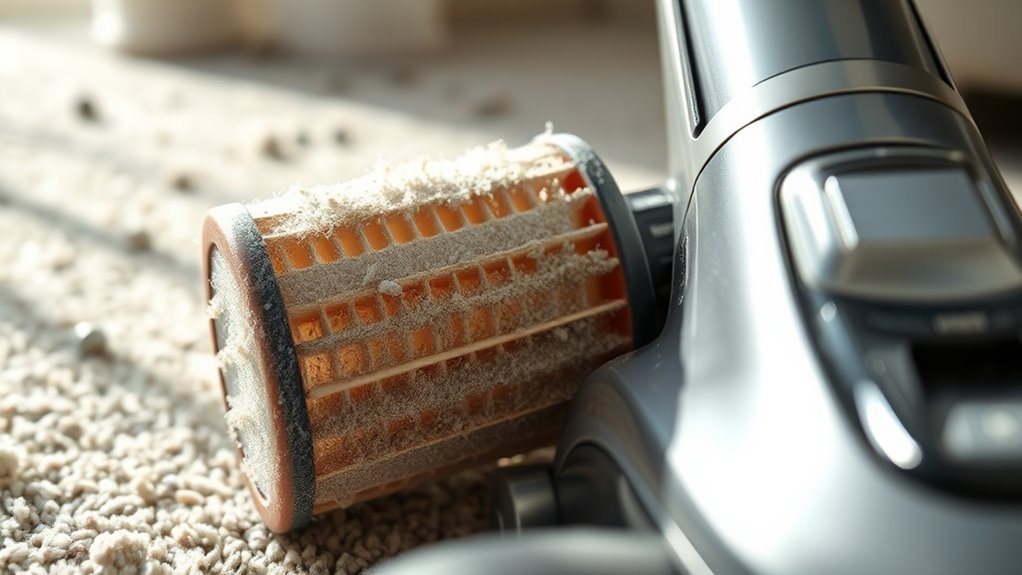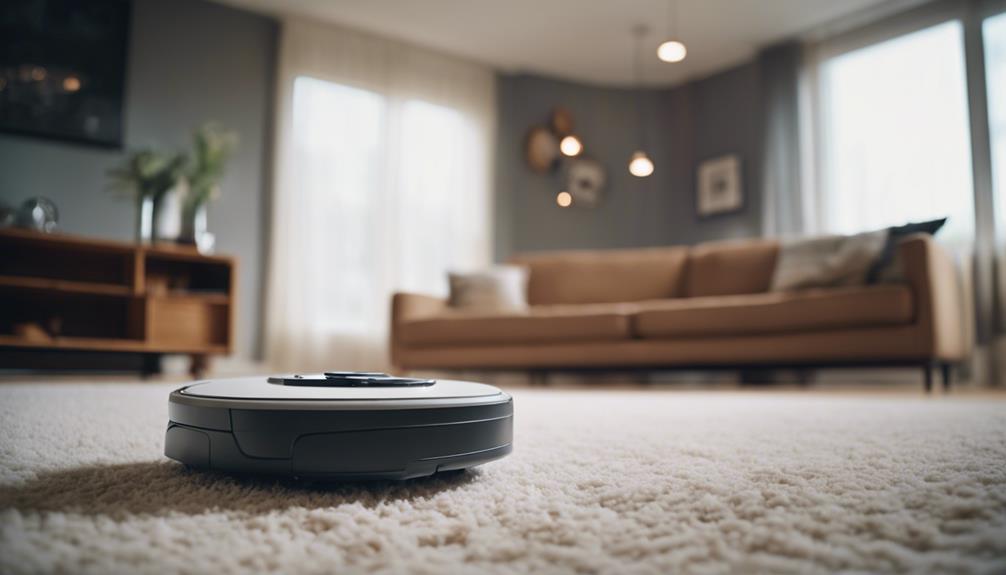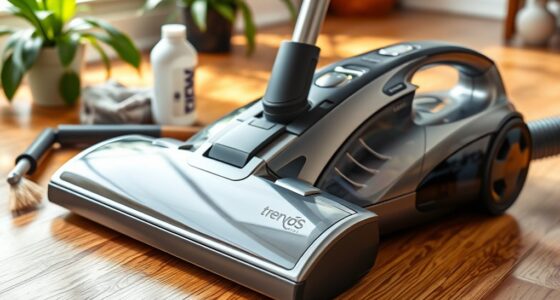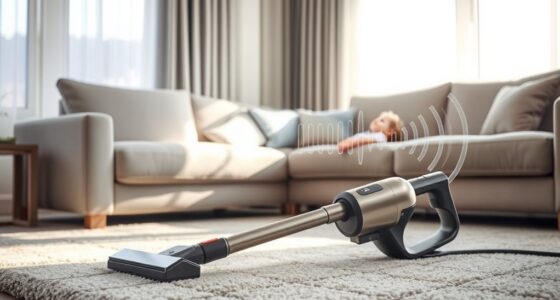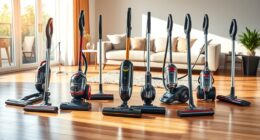Your vacuum’s suction drops over time due to common issues like clogged filters, full dust bags, and worn belts. Neglecting regular maintenance can lead to blockages in hoses and attachments, decreasing efficiency. Cleaning or replacing filters and emptying dust containers regularly can restore powerful suction. Checking seals for air leaks and understanding suction power settings also play an essential role. If you want to get your vacuum running smoothly again, there’s more helpful info ahead.
Key Takeaways
- Clogged filters and full dust bags can reduce suction by up to 30%, so clean or replace them regularly.
- Blockages in hoses or brush rolls can hinder airflow, requiring thorough inspections and cleaning to restore suction.
- Worn or broken belts affect brush roll operation, so check and replace damaged belts to improve performance.
- Regular maintenance, like filter cleaning and checking for obstructions, prevents suction loss and extends vacuum lifespan.
- Adjust suction power settings based on surface types to optimize cleaning results and maintain suction efficiency.
Common Causes of Lost Suction in Vacuums
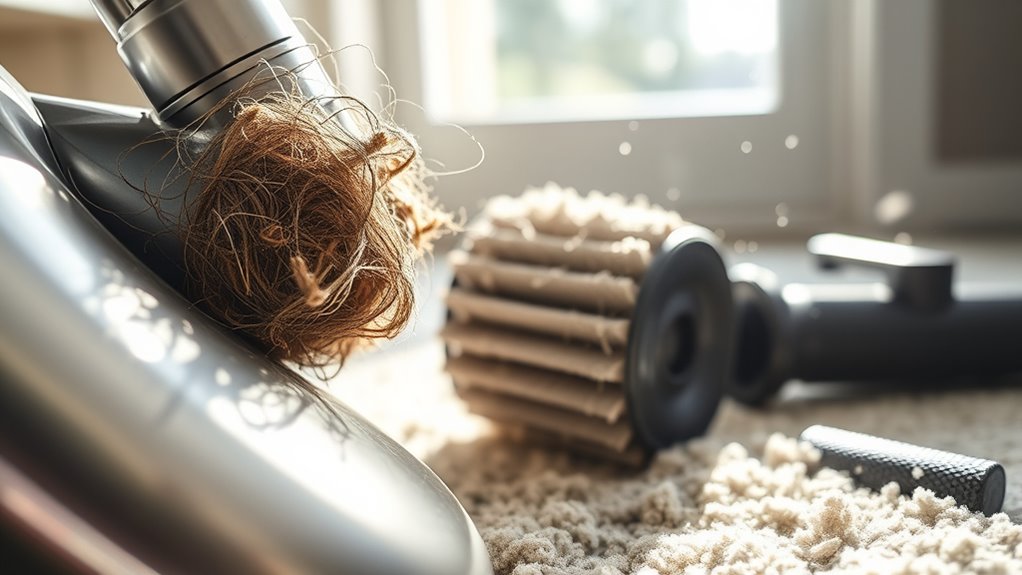
When your vacuum loses suction, it can be frustrating, but understanding the common causes can help you troubleshoot the issue.
One major culprit is clogged filters, which restrict airflow and greatly reduce cleaning efficiency. Check your dust bag, too; a full or improperly fitted dust bag can decrease suction power by up to 30%. Regularly replacing or cleaning your HEPA filters can significantly improve performance, as high suction power is essential for effective cleaning. Additionally, maintaining your vacuum’s filters is crucial to ensure optimal air quality. It’s also important to consider your vacuum’s compatibility with robot vacuum technology, as this can enhance cleaning efficiency.
Clogged filters and a full dust bag can significantly hinder your vacuum’s suction power and cleaning efficiency.
Don’t forget to inspect the vacuum cleaner’s hose for obstructions, as blockages in the brush rolls or air pathways can hinder airflow.
Additionally, worn or broken belts affect the brush roll’s operation, leading to further suction loss. If your vacuum’s aging components are causing issues, it might be time for replacements.
Regularly clean the filters and maintain your vacuum to keep suction strong. Following proper venting techniques during maintenance ensures optimal performance and efficiency.
Importance of Regular Maintenance
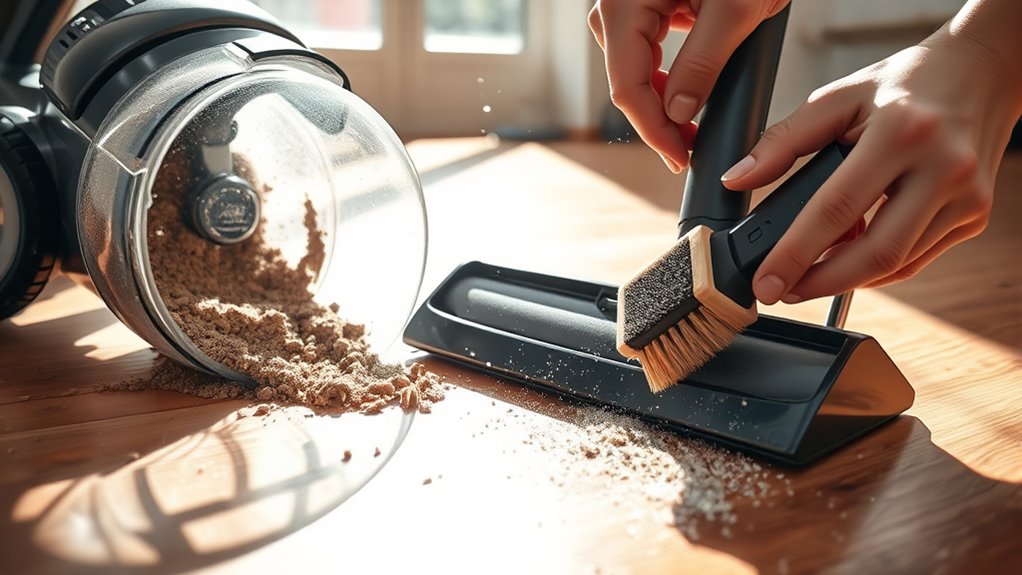
Regular maintenance is key to keeping your vacuum running smoothly and efficiently. By taking simple steps like cleaning filters and checking for blockages, you can’t only enhance suction power but also extend your vacuum’s lifespan. Regularly cleaning the vacuum’s exterior can also help maintain its performance and appearance. Additionally, a vacuum with effective filtration systems can significantly improve indoor air quality by reducing allergens and pollutants. For instance, using a vacuum that features strong suction is essential for effective cleaning. Maintaining home security systems is similar in that skipping these tasks might lead to bigger issues down the road, so staying proactive pays off. Just as homes equipped with security systems deter potential threats, a well-maintained vacuum prevents loss of performance over time.
Preventative Care Benefits
While you may not think about it often, maintaining your vacuum cleaner is vital for peak performance. By cleaning and replacing filters regularly, you can maintain maximum suction and restore power by up to 30%. Regular filter replacement is recommended every 6-12 months to maintain optimal performance and efficiency. Additionally, consistent maintenance of your vacuum can prevent costly repairs and replacements. Incorporating regular maintenance into your routine is similar to how low carb diets necessitate careful meal planning to achieve desired results. Furthermore, just as freshly squeezed juices can spoil quickly without proper storage, neglecting this important step often leads to loss of suction and common vacuum cleaner problems, such as blockages in hoses or wear on brush rolls. Routine checks help you catch issues early, guaranteeing efficient airflow and preventing costly repairs or the need for a replacement. Additionally, proper maintenance enhances cleaning effectiveness and guarantees safer operation, reducing the risk of overheating and fire hazards from obstructed airflow. Investing time in maintenance now can save you headaches down the road. Regular filter changes can also lead to improved indoor air quality by reducing harmful airborne pathogens, benefiting your overall health.
Enhanced Vacuum Lifespan
Maintaining your vacuum cleaner not only boosts its performance but also considerably extends its lifespan. Regular maintenance is key to guaranteeing your vacuum operates efficiently. By cleaning or replacing filters, you prevent clogs and maintain ideal suction power. Keeping the dust container emptied and clean is crucial—did you know a full container can reduce suction by up to 30%? Additionally, hydration and nutrition play a significant role in keeping you energized while performing household tasks. Regularly inspecting the brush roll and belts reduces wear on the motor, while checking hoses for blockages prevents overheating. Following the manufacturer’s guidelines guarantees your vacuum enjoys an enhanced lifespan. Additionally, using high suction power ensures that your vacuum can tackle pet hair and other debris effectively. Understanding how smart toilets can improve overall hygiene may also enhance your home maintenance routine. Furthermore, neglecting maintenance can lead to increased emissions and air pollution, similar to the consequences of improper wood-burning practices.
| Task | Frequency | Benefit |
|---|---|---|
| Clean or replace filters | Every 1-3 months | Prevents clogs |
| Empty dust container | After each use | Maintains suction power |
| Inspect brush roll | Monthly | Reduces motor wear |
| Check hoses for blockages | Monthly | Prevents overheating |
Checking for Blockages in Hoses and Attachments
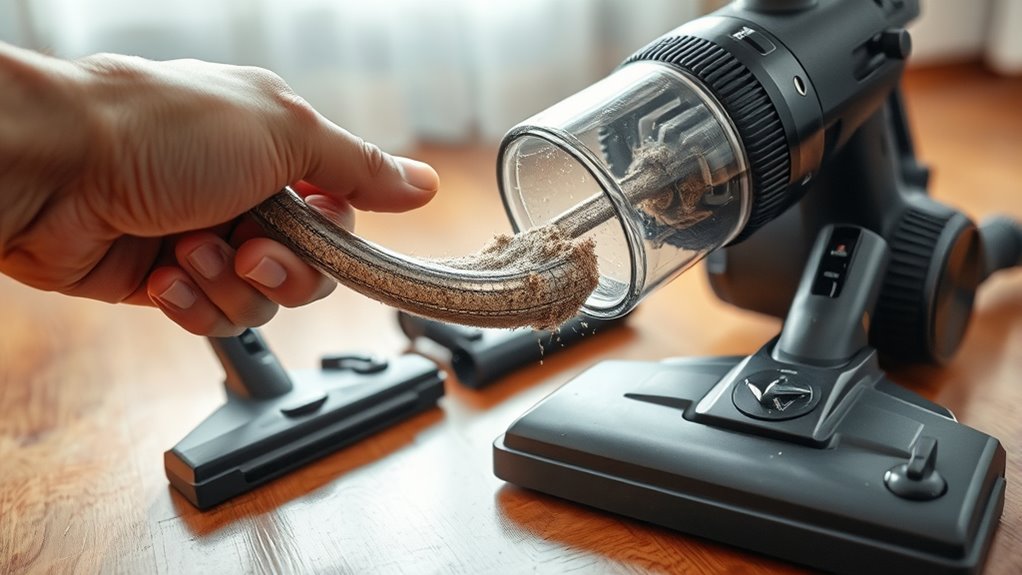
To guarantee your vacuum performs at its peak, it’s crucial to regularly check for blockages in hoses and attachments.
Start by inspecting the hoses for visible obstructions, as any blockages can seriously restrict airflow and reduce suction power. Use a flashlight to look deeper into the hoses for hidden debris that mightn’t be immediately noticeable. Regularly checking these areas can help prevent significant drops in suction and maintain optimal performance. Additionally, ensuring that your vacuum’s filter maintenance is up to date can further enhance airflow efficiency.
Don’t forget to detach all attachments and examine them individually; even small items stuck in the brush roll or nozzle can hinder performance. If you find debris, use a long, flexible brush or a straightened wire hanger to dislodge it carefully.
For stubborn blockages, flushing the hoses with warm water can help clear built-up dirt and restore maximum suction flow. Regular maintenance and inspections can reduce incidents of toy breakage due to wear and ensure your vacuum operates effectively.
Cleaning or Replacing Filters
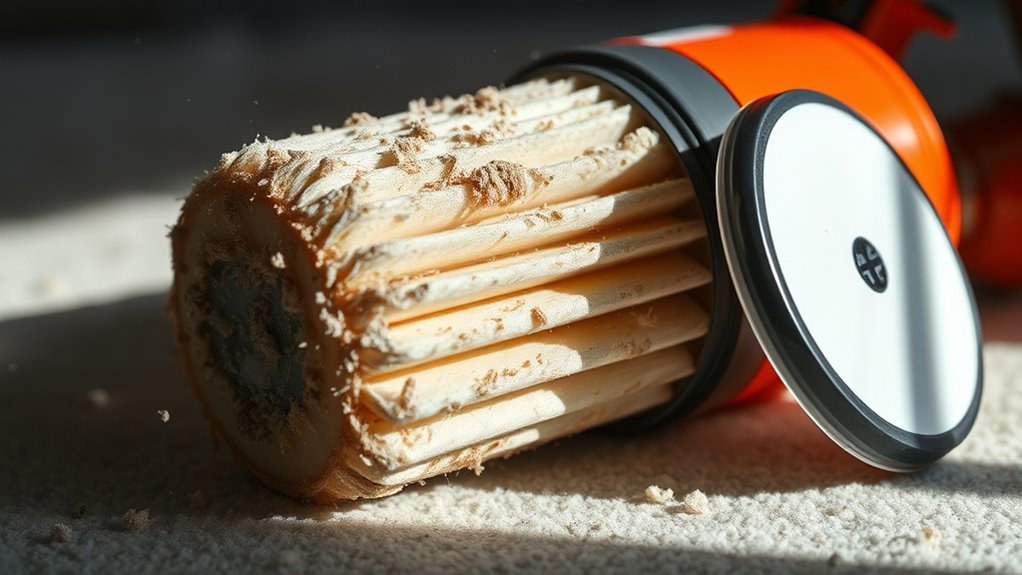
Cleaning or replacing filters is essential for keeping your vacuum running smoothly, as clogged filters can restrict airflow and reduce suction power considerably.
Regular maintenance is key; inspect HEPA and foam filters at least once a month. Washable filters should be rinsed and dried for 24 hours before reinserting.
Inspect HEPA and foam filters monthly, and rinse washable ones before reinserting to ensure optimal vacuum performance.
If your vacuum has self-cleaning filters, twist the dial to shake dirt free, boosting performance without extra effort.
Don’t forget to replace filters that are torn or excessively worn, as damaged filters let dirt bypass the system, diminishing suction.
Following the manufacturer’s guidelines for cleaning and replacement guarantees peak suction and prolongs your vacuum’s life, keeping your home cleaner and your vacuum working effectively.
Emptying Dust Bags or Containers
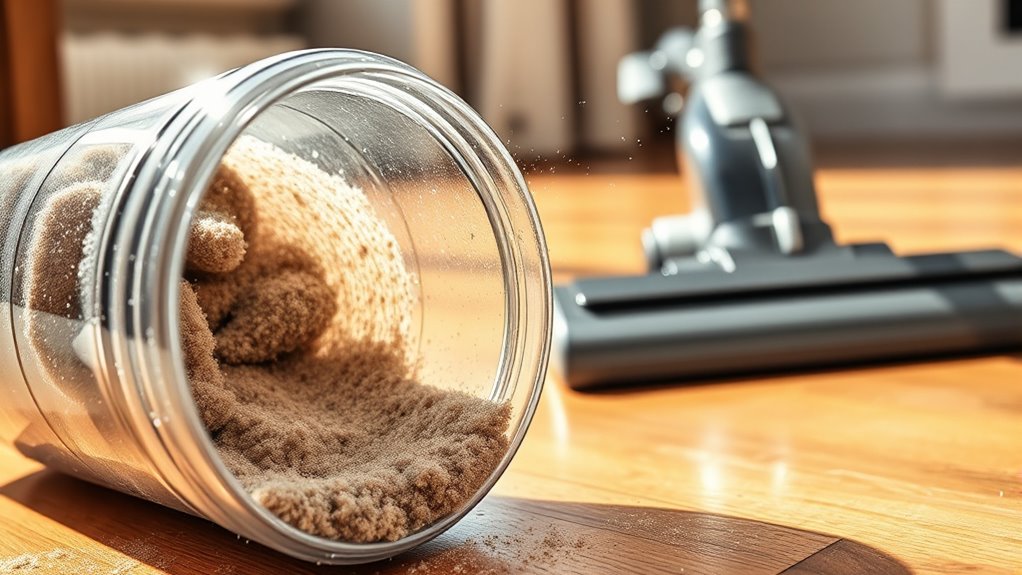
While it might be tempting to overlook the dust bag or container after a vacuuming session, regularly emptying it is crucial for maintaining peak suction power. A full dust bag or container can reduce your vacuum’s suction by up to 30%.
For best performance, remember to:
- Empty dust bags or containers after each use.
- Make sure bagless dust containers are emptied at the maximum fill line.
- Replace the bag when it’s about 75% full.
- Follow manufacturer guidelines for best practices.
Neglecting these simple tasks can lead to suction problems and increased wear on your vacuum’s motor.
Inspecting the Brush Roll and Belt

To keep your vacuum running smoothly, you should regularly check the brush roll for tangled hair and debris.
A clean brush roll not only improves suction but also extends the life of your vacuum.
Don’t forget to inspect the belt for wear and tear, as a damaged belt can stop the brush roll from spinning altogether.
Check for Tangled Debris
One of the most common culprits behind diminished suction in your vacuum is tangled debris on the brush roll. When hair, string, or other materials wrap around it, they restrict bristle movement, leading to a decline in suction performance.
To maintain your vacuum’s cleaning efficiency, it’s essential to inspect the vacuum cleaners regularly.
Here are some tips to keep in mind:
- Check the brush roll for any visible tangles.
- Remove hair and debris carefully with scissors.
- Verify the bristles can move freely for peak suction.
- Regular maintenance can prevent future issues.
Inspect Belt Condition
After checking for tangled debris on the brush roll, it’s time to inspect the belt condition. A worn or broken belt can lead to significant suction issues because it prevents the brush roll from spinning effectively.
Detach the brush roll and visually check for any signs of wear, fraying, or breakage. If you notice any damage, replacing the belt can restore suction efficiency.
Additionally, check the belt’s tension regularly; a loose belt can also cause reduced suction by hampering the brush roll’s effectiveness.
Most vacuum cleaner belts are inexpensive and simple to replace, making regular inspections a smart maintenance step.
Evaluating Seals and Gaskets for Air Leaks
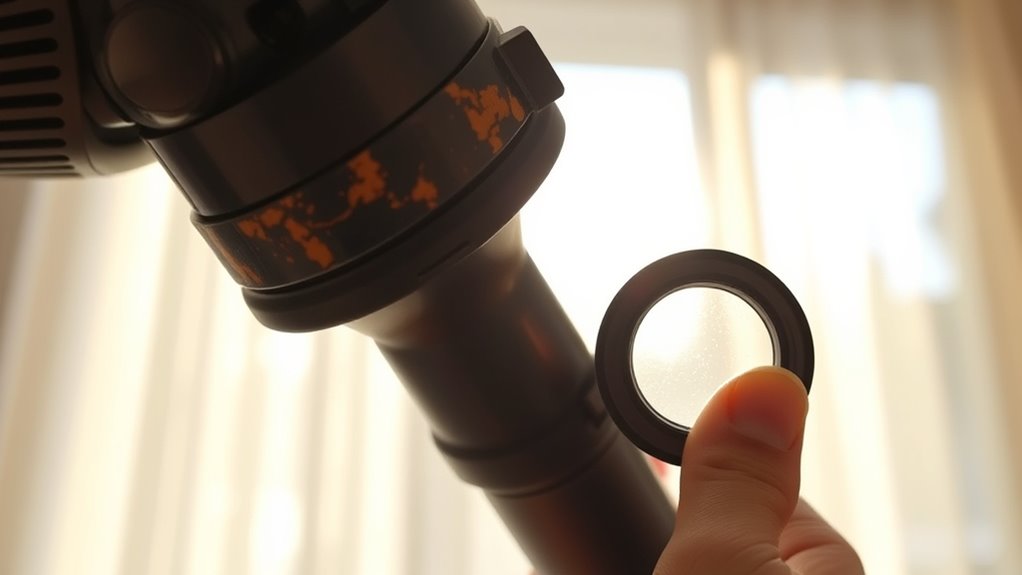
How can you guarantee your vacuum cleaner maintains its powerful suction? Evaluating seals and gaskets for air leaks is essential for peak performance.
To ensure your vacuum cleaner’s powerful suction, regularly evaluate seals and gaskets for air leaks.
These components prevent air leaks that can greatly reduce suction. Regularly inspect them for signs of wear, such as cracks or tears.
- Clean seals and gaskets to remove dirt and debris.
- Check for proper alignment and fit to avoid airflow leaks.
- Replace worn or damaged seals and gaskets promptly.
- Maintain a tight seal against the vacuum body for maximum suction.
Understanding Suction Power Settings
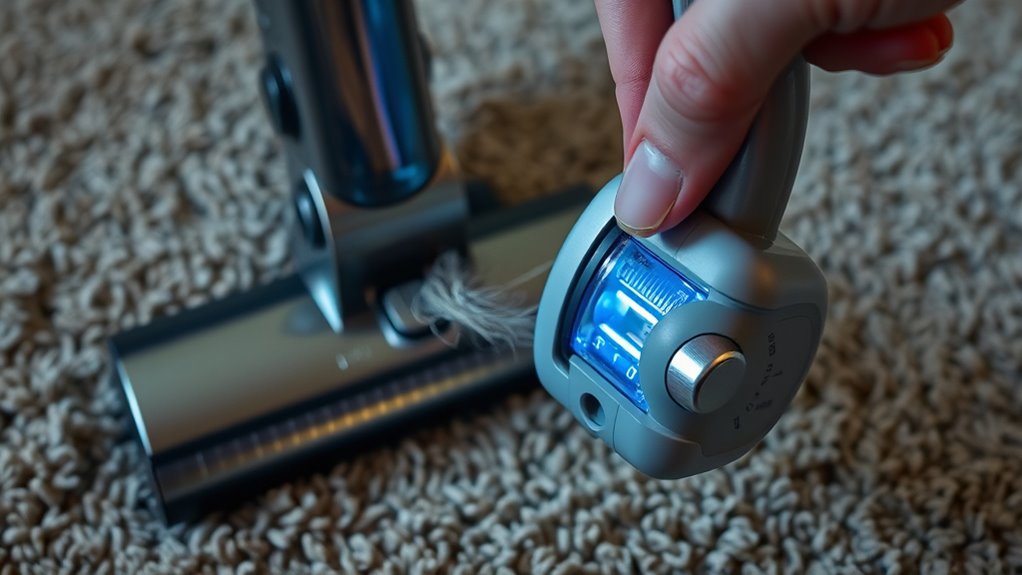
When you adjust the suction power settings on your vacuum, you can tailor its performance to suit different surfaces, like carpets or hard floors.
You’ll also notice how testing these variations can greatly enhance your cleaning efficiency.
Understanding these settings is key to achieving ideal results while protecting your vacuum’s longevity.
Adjusting for Surface Types
Adjusting the suction power of your vacuum cleaner is essential for achieving ideal cleaning results on different surfaces. By fine-tuning the settings based on the surface type, you can efficiently tackle dirt and debris while prolonging the life of your vacuum.
- Use higher suction for carpets to lift deep-set dirt and debris.
- Lower suction settings are perfect for delicate surfaces like curtains or upholstery.
- Take advantage of specialized attachments to enhance cleaning efficiency on various materials.
- Consider advanced models that automatically adjust suction based on the detected surface type.
Regularly adjusting suction power not only improves cleaning efficiency but also reduces strain on the motor, ensuring your vacuum lasts longer and performs better.
Testing Performance Variations
Testing your vacuum’s performance variations is essential for maximizing its cleaning capabilities. Different suction power settings can greatly impact your vacuum’s cleaning efficiency, especially when tackling various types of debris.
By adjusting the suction power according to the surface—like carpets versus hard floors—you enhance the vacuum’s ability to pick up dirt effectively. To assess performance variations, observe how well your vacuum performs at each setting, noting any notable changes in suction effectiveness.
Higher settings often yield better results for heavier particles, while lower settings can prevent strain on the motor during lighter tasks. Regularly making these adjustments not only optimizes cleaning but also prolongs your vacuum’s lifespan, ensuring it operates at its best.
Assessing the Impact of Age on Vacuum Performance

As vacuum cleaners age, their performance often declines, primarily due to the wear and tear on internal components like motors, belts, and seals.
You may notice a significant drop in suction power, with research showing a 30% decrease within the first five years. Accumulated dust and debris in filters and hoses further contribute to this loss, making regular maintenance essential.
Here are some key points to take into account:
- Older models often face more frequent problems.
- Maintenance becomes vital for restoring suction.
- Newer cleaners typically offer better durability.
- Dust buildup can severely impact performance.
When to Seek Professional Assistance
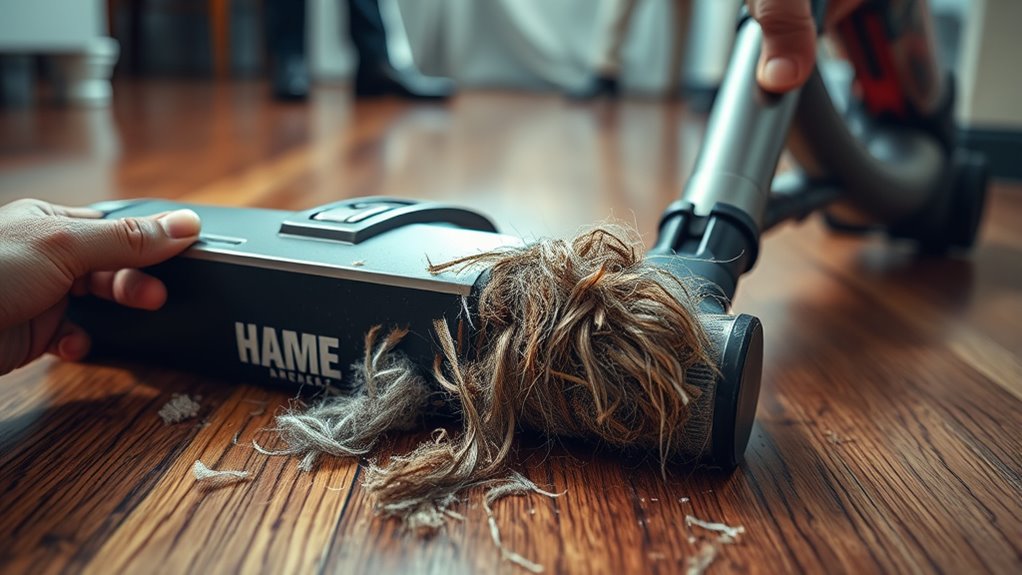
When your vacuum starts showing persistent suction problems despite your best troubleshooting efforts, it may be time to call in a professional.
They can diagnose and fix issues that you’ve been unable to resolve, like persistent blockages or unusual noises. If you notice any overheating or burning smells, don’t hesitate—these could indicate serious motor problems that need expert evaluation.
Professionals have access to genuine replacement parts, ensuring your vacuum operates efficiently and safely. If you’ve performed regular maintenance yet your vacuum’s performance still declines, consulting a professional can provide insights into underlying issues.
Frequently Asked Questions
Why Do Vacuums Lose Suction Over Time?
Vacuums lose suction over time for several reasons.
Clogged filters restrict airflow, while full or improperly fitted dust bags reduce air space, impacting suction power.
You might also find debris obstructing brush rolls, hoses, or air pathways, which can greatly impair performance.
Worn or broken belts affect the efficiency of the brush roll, and gaps in seals or gaskets can lead to air leaks, compromising your vacuum’s overall effectiveness.
Regular maintenance is key!
How Do You Restore a Vacuum Suction?
When it comes to restoring your vacuum’s suction, you’ll want to get the ball rolling by checking and cleaning or replacing clogged filters.
Empty the dust bag or container regularly, since a full one can really drag down performance.
Don’t forget to inspect hoses and brush rolls for blockages.
Finally, make certain seals are intact and maintain the brush roll and belt.
With these steps, you’ll have your vacuum working like new in no time!
What Could Cause a Drop in Suction Power of the Vacuum Cleaner?
A drop in suction power can happen for several reasons.
You might find that clogged filters are blocking airflow, or a full dust bag is limiting space for suction.
Check for hair or debris tangled in the brush rolls and hoses; they can hinder performance.
Additionally, worn belts may not drive the brush roll effectively, and age-related wear on internal components can gradually reduce suction.
Regular maintenance can help keep your vacuum running strong.
Do Suction Cups Lose Suction Over Time?
Did you know that up to 25% of suction cups lose their grip after just a few weeks of use?
Yes, suction cups do lose suction over time. This happens because the rubber material degrades, affecting its flexibility and seal.
Dirt and moisture build-up can also hinder adhesion. Plus, temperature changes and regular wear can cause cracks or warping.
To keep them effective, clean your suction cups regularly and replace them when needed.
Conclusion
Just like a car needs regular oil changes to run smoothly, your vacuum thrives on maintenance to keep its suction strong. Imagine trying to drink a thick milkshake through a straw with a hole in it—frustrating, right? By checking for blockages, cleaning filters, and ensuring seals are intact, you can restore your vacuum’s power. Don’t wait for it to sputter and stall; treat it well, and it’ll keep your home spotless for years to come.
